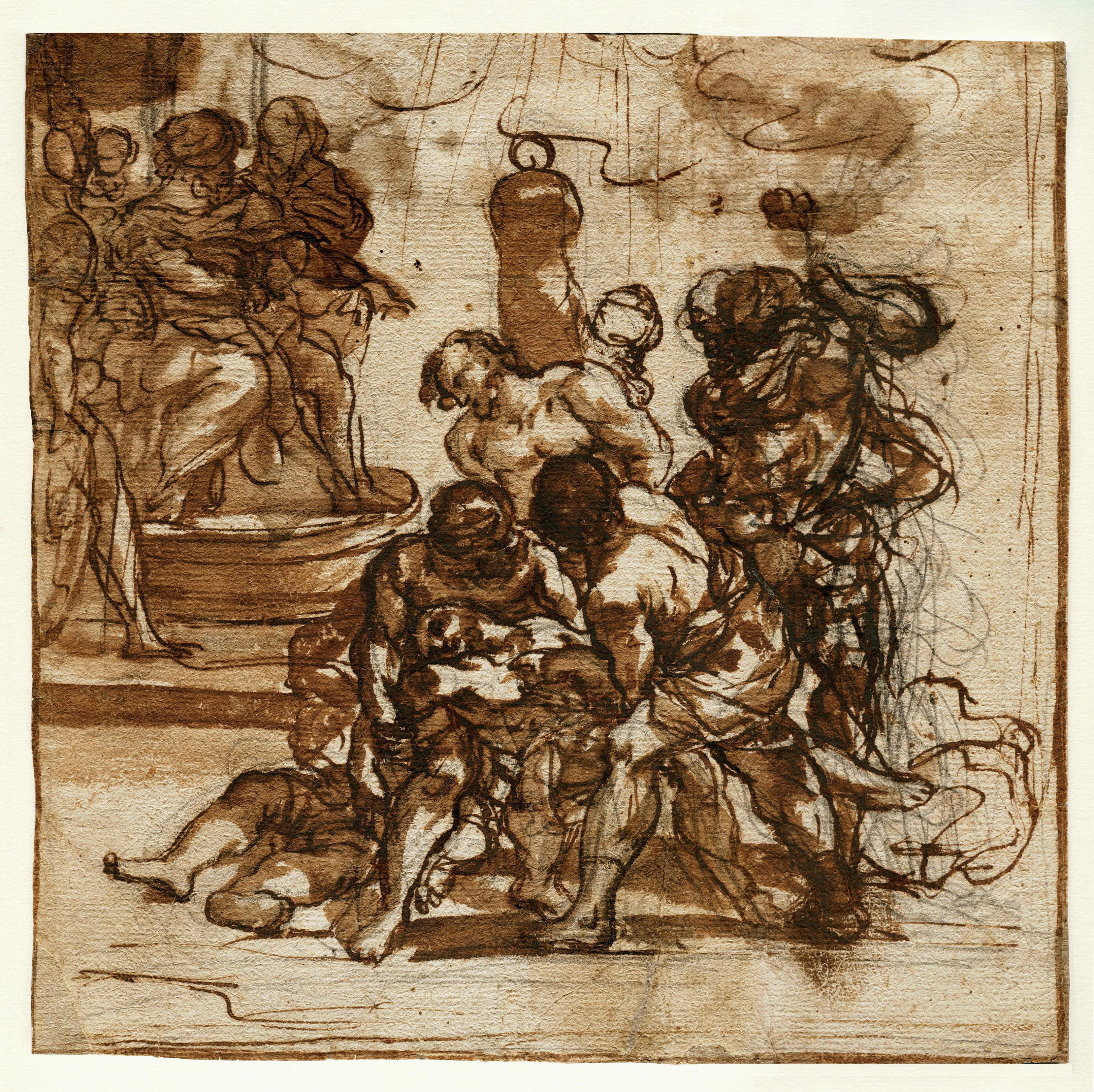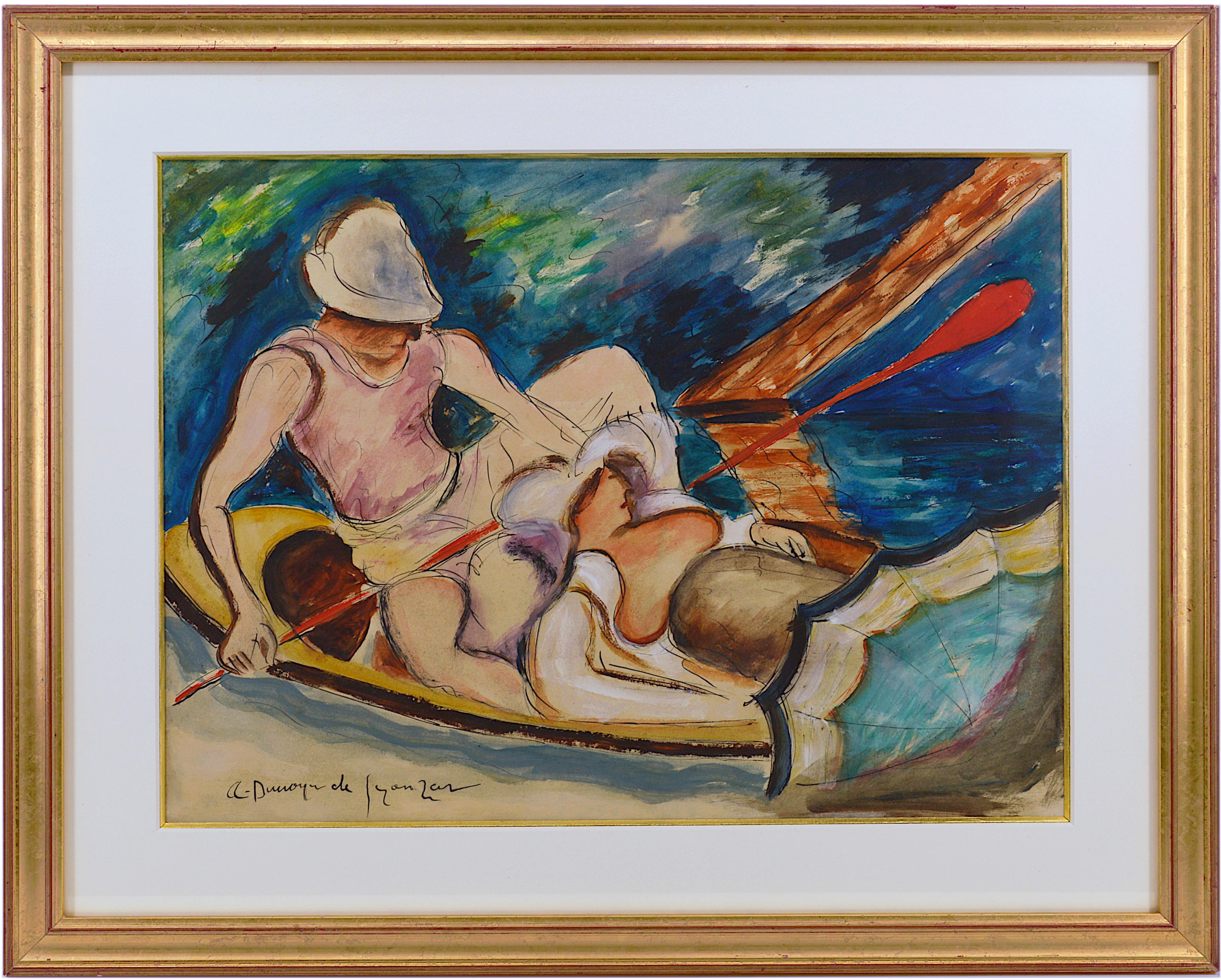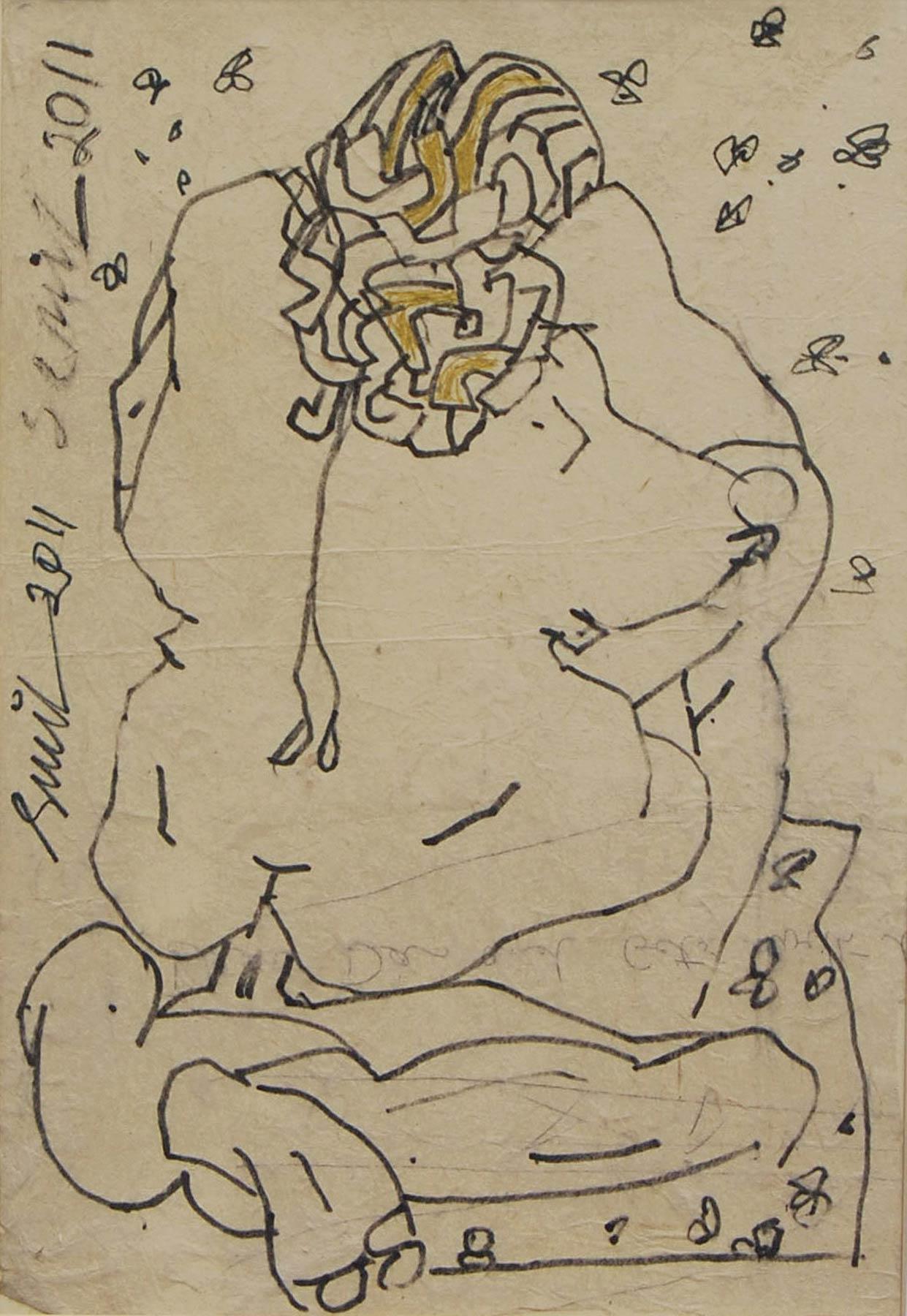Items Similar to Study of a Nude Man
Want more images or videos?
Request additional images or videos from the seller
1 of 2
Francesco MaffeiStudy of a Nude Man17th Century
17th Century
About the Item
Provenance:
John Barnard, London (Lugt 1419) or possibly Saint John Dent, London and Milton (Lugt 1438)
Unidentified collector’s mark “W,” lower left of the mount (Lugt 2591a)
Private Collection, USA.
This expressive and boldly executed drawing is a work by Francesco Maffei, recently identified as such by Rick Scorza (written opinion). Despite his provincial training in his native Vicenza, Maffei is known for the complexity of his artistic sources and inspiration. Although a fully Baroque artist, his technique and style recalls and builds upon the giants of Venetian art of previous generations. Maffei was heavily influenced by Veronese and Tintoretto, to whom this drawing had traditionally been attributed. A residence in Venice in the late 1630s, where he came into direct contact with Santo Peranda, Johann Liss, Domenico Fetti, and Bernardo Strozzi, had a further impact on his development.
Our drawing stands out for its spontaneous handling, as Maffei fully exploits the dynamics of the pen and of wash. The lines are vigorous and the figure animated, combining to create a wonderfully dynamic figure. The figure is placed close to the pictorial plane, with the bottom of his foot visible, as if he is about to step out of the drawing. The position of the figure finds a close counterpart in Maffei’s Justice in the Museo Civico in Vicenza (Fig. 1).
In the 19th century, our drawing was paired with a similar work by Maffei, which appeared at Dorotheum in 2009 (Fig. 2). The two drawings seem to have passed through several subsequent collections together. Both drawings retain related but unidentified inscriptions on the reverse—ours “Horenville No 150” and the Dorotheum drawing “Horenville No 151” (likely an unidentified collector’s inscription). In addition to being mounted in the same manner same, they also share old inscriptions attributing the drawings to Jacopo Tintoretto.
- Creator:Francesco Maffei (1605 - 1660, Italian)
- Creation Year:17th Century
- Dimensions:Height: 7.75 in (19.69 cm)Width: 4.75 in (12.07 cm)
- Medium:
- Movement & Style:
- Period:
- Condition:
- Gallery Location:New York, NY
- Reference Number:1stDibs: LU10211813142

About the Seller
5.0
Recognized Seller
These prestigious sellers are industry leaders and represent the highest echelon for item quality and design.
Established in 1997
1stDibs seller since 2012
17 sales on 1stDibs
Typical response time: 11 hours
- ShippingRetrieving quote...Ships From: New York, NY
- Return PolicyThis item cannot be returned.
More From This SellerView All
- The Martyrdom of the Santi Quattro CoronatiLocated in New York, NYProvenance: Private Collection, UK After initial training under Justus Suttermans and Vincenzo Dandini, in 1673 Anton Domenico Gabbiani embar...Category
17th Century Old Masters Figurative Drawings and Watercolors
MaterialsChalk, Paper, Ink, Pen
- A Musical PartyBy German SchoolLocated in New York, NYProvenance: Dr. George Hamilton, Massachusetts; and by descent. Private Collection, Ohio, until 2021. Exhibited: (Possibly) Clark Art Institute, Massachusetts (according to a handwritten inscription on the reverse). This drawing by an anonymous, 16th-century German hand presents a delightful scene of nymphs—mostly nude but some draped with cloth—making music in an outdoor setting. The composition is executed within a roundel and centers on the harpsichord played by the figure seen from behind. She is accompanied by a host of other instruments, including horns, a harp, and a lira da gamba played by figures gathered nearby, several of which are positioned along the curved edges of the visual field. Two satyrs observe the merrymaking—one leans on the harpsichord while the other holds aloft a cup, presumably of wine, adding a bacchic element to the revelry. The drawing was previously owned by Dr. George Hamilton, scholar of modern art and Director of the Sterling and Francine Clark Art Institute in Williamstown (1966–1977). Hamilton played...Category
16th Century Old Masters Landscape Drawings and Watercolors
MaterialsInk, Paper, Pen
- Study after Michelangelo’s “The Last Judgment”By Michelangelo BuonarrotiLocated in New York, NYItalian School, 16th Century Provenance: Private Collection, New York This intriguing drawing is a study by an anonymous 16th-century Italian artist after a vignette in Michelangelo’s fresco of The Last Judgement in the Sistine Chapel. The altar wall of the Sistine Chapel was already richly decorated when Pope Clement VII commissioned Michelangelo to paint his Last Judgment...Category
16th Century Old Masters Figurative Drawings and Watercolors
MaterialsGouache, Paper
- Study of JobBy Lesser UryLocated in New York, NYSigned, dated, and titled, lower left: L Ury/ 1883/ Studie zum Hiob Provenance: Mr. and Mrs. Dennis Berger, New York, until 2005; thence by descent. Literature: Illustrated in...Category
Late 19th Century Impressionist Nude Drawings and Watercolors
MaterialsBoard, Charcoal
- Orpheus and the Animals, A Study after an Ancient Bas-ReliefLocated in New York, NYInscribed “55” and “218” in the lower right Watermark: Heawood 1351 Laid down on historic Cassiano Del Pozzo mount (Mount Type A, 531 x 402 mm) Provenance: Commissioned by Cassiano dal Pozzo (1588–1637) for his Museo Cartaceo (Paper Museum) and kept in the library of his palazzo, via dei Chiavari, Rome Transferred with the entire dal Pozzo collection by fidecommesso to his younger brother, Carlo Antonio dal Pozzo (1606–1689); by descent to his second son: Gabriele dal Pozzo (d. 1695); by descent to his wife: Anna Teresa Benzoni and after her remarriage in 1697, the Marchesa Lancellotti de’ Ginnetti (d. 1736); by descent to their son: Cosimo Antonio dal Pozzo (d. 1740); by whom sold with the Dal Pozzo library in 1703 to: Pope Clement XI for the Vatican Library; by whom transferred as part of the Museo Cartaceo in January 1714 to his nephew: Cardinal Alessandro Albani (1692–1779), Palazzo ‘alle Quattro Fontane’ in Rome; by whom sold in 1762 to: James Adam, agent for the British Royal Librarian Richard Dalton (1715–1791) King George III of England, Buckingham House Among the sheets of the ‘Museo Cartaceo’ appropriated by Richard Dalton during a reorganization of the drawings, circa 1786-1788; his estate sale, Greenwood’s, London, 11-19 May 1791; where acquired by: John MacGowan...Category
16th Century Baroque Figurative Drawings and Watercolors
MaterialsPaper, Ink, Pen
- The Flight into EgyptLocated in New York, NYInscribed: 3. una Madonna che va in Egitto, verso, and Madonna che va in Egitto, recto Provenance: Private Collection, UK, since 1999 This expressive and boldly executed drawing is the work of Luca...Category
16th Century Old Masters Figurative Drawings and Watercolors
MaterialsInk, Paper, Chalk, Pen
You May Also Like
- "Boating on the Morin River"By André Dunoyer de SegonzacLocated in Saint Amans des cots, FRPen, ink, watercolor and wash on paper by André Dunoyer de Segonzac, France, 1922-1924. Boating on the Morin River. Measurements : with frame: 52.5x65x2 cm - 20.7x25.6x0.8 inches / without frame: 36.5x45 cm - 14.4x17.7 inches. Signed lower left "A. Dunoyer de Segonzac". Colors may vary slightly depending on your screen. The lighter band at the top and the bottom of the piece, visible in the first picture, is only due to the reflection in the protective glass. It does not exist. In its frame gilt with gold leaf and its protective glass. André Dunoyer de Segonzac was born in Boussy-Saint-Antoine (Essonne) July 7, 1884. After his schooling at high school Henri IV, as early as 1900, he attends classes at the National School of Fine Arts in Paris in free listener where he will befriend Charles Dufresne. In 1903, he enters the private studio of Luc-Olivier Merson. In 1907, he studies with Jean-Paul Laurens and attends the La Palette and Colarossi academies in Montparnasse. He meets Luc-Albert Moreau and Jean-Louis Boussingault with whom he shares a studio. His first drawings are published in 1908 in The Great Review and The Witness. Nearly indifferent to contemporary aesthetic revolutions, Dunoyer de Segonzac undertakes, with Jean-Louis Boussingault and Luc-Albert Moreau, to revive Gustave Courbet's realism by performing still lifes, nudes, landscapes, in a thick paste and masonry . In one of his letters to the painter Maurice Boitel, he wrote in the 1950s: "I have not forgotten the heroic period of the independents - when we were grouped around Paul Signac, the charming and valiant Maximilien Luce - in these barracks where the living and authentic Art was grouped outside the academic formulas - or literary and systematic tendencies - which were to lead to this abstract aesthetic of which the painting dies. " In 1908, he begins exhibiting at the Salon d'Automne and the Salon des Indépendants, with Paul Signac and Maximilien Luce. He befriends Apollinaire, Max Jacob, Raoul Dufy and Vlaminck. From this period, renting a house belonging to Signac, Dunoyer discovers the landscapes of Saint-Tropez, to which he will remain faithful and where he lived until the end of his life. He stays in Saint-Tropez only in the summer season. For the rest, he leads a real nomadic life, in search of the motive especially through the Île-de-France, the Grand Morin valley, Feucherolles, Chennevières-sur-Marne, Guyancourt, etc. "I also worked a lot on the banks of the Seine in Chatou, Bougival, Andrésy, Poissy and Triel that I particularly like, with its beautiful Gothic church that is reflected in the Seine and the high wooded hills that surround him", he will say. In 1910, he knows fashion designer Paul Poiret and meets Max Jacob, Raoul Dufy and Vlaminck. From 1910 to 1914, he travels to Italy, Spain, North Africa, and is interested in sport and dance (drawings of Isadora Duncan's Russian Ballets, 1911, The Boxers1910). From 1914 to 1918, mobilized in the infantry, he makes the war hardly, before being assigned to camouflage. He performs many war drawings, valuable for their artistic and documentary value. From 1919, he appears again in many exhibitions, including major Parisian salons. Nearly indifferent to contemporary aesthetic revolutions, Dunoyer de Segonzac undertakes, with Boussingault and Moreau, to revive Courbet's realism by performing still lifes, nudes, landscapes, in a thick and masonry paste. Enlisted in engraving by Jean Émile Laboureur, he makes nearly 1,600 brass plaques from 1919 to 1970. He was president of the Society of French painters-engravers. In 1921, he meets Paul Valéry, Léon-Paul Fargue and Jean Cocteau. In 1928, he makes a trip to America where he met with great success. In 1930, he becomes friend with Derain. In 1933 he receiveds the Carnegie Foundation of Pittsburgh Award and in 1934 the Venice Biennale. During the Occupation, in November 1941, he takes part in a "study trip" to Germany, organized by Arno Breker, accepting, like other artists of the most renowned, to visit the hotspots of German culture as well as artist workshops. After the war, he is exhibited in the best galleries...Category
1920s Realist Figurative Drawings and Watercolors
MaterialsPaper, Ink, Watercolor, Pen
- Study for “L’Acropole”By Paul DelvauxLocated in New Orleans, LAPaul Delvaux 1897-1994 Belgian Study for “L’Acropole” Signed and dated "P.Delvaux 1965" (lower right) Watercolor, pen and ink on paper This preliminary drawing for Paul Delvaux’s greatest masterpiece L’Acropole, which resides today in the Centre Pompidou in Paris, features the artist’s most beloved subject — mystical scenes of nude women. A centrally-placed, stoic woman draped in a long green gown stands with her arms outstretched by her sides. She gazes at another idealized woman in the foreground, lying nude on a chaise lounge, while behind her, multitudes of other women in white dresses undertake a long procession towards a distant door. The captivating scene exudes the unique Surrealist style for which the artist has become known. With this skillful rendering of the surreal setting, Delvaux has mastered depicting nude women in a sensual yet non-erotic manner. The artist drew inspiration from a variety of sources, including the futuristic writings of Jules Verne and the mythos of Homer, and blended them with his subconscious themes, which frequently included the nude female form. In combination with the loose concepts of form and perspective found in the 16th-century Mannerist paintings that Delvaux studied in Italy before World War II, his distinctive style served to create memorable dreamscapes without veering into lewdness. Like the very best Surrealist images, the work is both innovative and engaging. Paul Delvaux's earliest and most lasting influences in his art were the futuristic writings of Jules Verne and the mythos of Homer. After completing his initial artistic training at the Académie Royale des Beaux-Arts in Brussels, Delvaux exhibited with Surrealists Dalí...Category
20th Century Post-Impressionist Nude Drawings and Watercolors
MaterialsPaper, Ink, Watercolor, Pen
- Making Love Series II, Nude, Pen & Ink on Paper Pasted on Board "In Stock"By Sunil DasLocated in Kolkata, West BengalSunil Das - Making Love Series II - 9 x 7 inches (unframed size) Pen and Ink on Paper Pasted on Board Inclusive of shipment in ready to hang form. Sunil D...Category
2010s Modern Nude Paintings
MaterialsInk, Pen, Board, Paper
- Nude Woman, Drawing, Ink, Marker on Paper by Modern Indian Artist"In Stock"By Prakash KarmarkarLocated in Kolkata, West BengalPrakash Karmakar - Untitled - 23 X 20 inches (unframed size) Marker on Paper Delivery of shipment in ready to hang condition. Style : Legendary master artist Lt. Prokash Karmakar fr...Category
1990s Modern Figurative Drawings and Watercolors
MaterialsPermanent Marker, Ink, Paper
- Woman seated in Garden, Nude, Ink on paper by Modern Indian Artist "In Stock"By Prakash KarmarkarLocated in Kolkata, West BengalPrakash Karmakar - Untitled - 23 x 20 inches Marker on Paper , 2002 Delivery of shipment in roll form. Style : Legendary master artist Lt. Prokash Karmakar from Bengal was solely re...Category
Early 2000s Modern Figurative Drawings and Watercolors
MaterialsInk, Permanent Marker, Paper
- Nude 1664, David Jones, Original Drawing, Figurative Portraiture Artwork, BlackBy David Jones, CH, CBELocated in Deddington, GBOff white – Daler Rowney best quality cartridge paper. Supplied with mount. Size: H:50 cm x W:40 cm David Jones, artist draws Matisse style life drawings. David Jones framed and un...Category
21st Century and Contemporary Minimalist Portrait Drawings and Watercolors
MaterialsPaper, Ink, Pen
Recently Viewed
View AllMore Ways To Browse
Antique Pen Stand
Wash Stand 19th
19th Century Wash Stand
19th Century Pen And Ink Drawings
Pen And Ink Stand
Antique Milton
Santos Figure
Santos Saints
17th Ink Drawings
17th Century Ink Drawings
Pair Venice Paintings
Saint Francesco
17th Century Venetian Paintings
John Fig
Pair Of Venetian Paintings
Antique Pen And Ink Stand
Painting 151
Giant Pen





